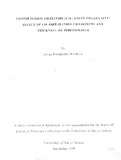| dc.description.abstract | The effect of CulnSe, thin film preparation conditions and thickness on CuInSe2 based
solar cells has been investigated. Prior to CuInSe2 thin films and device fabrication,
metallic Cu and In resistivity changes with deposition conditions were studied. The
CuInSe2 thin films were fabricated by two stage process which involved DC sputtering
of metallic CuIn bilayers followed by reaction of the bilayers in H2Se gas in a chemical
vapor deposition reactor.
Metallic Cu and In films resistivities depend on vacuum deposition conditions as well
as their thicknesses. For deposition parameters studied in this work, Cu film
resistivity changes are within the order of 101 while those for In film were up to order
of 1011.
A semi quantitative description on the formation of CuInSe2 films with respect to
reaction period, reaction temperature, and precursor thickness has been given. This
has helped to explain the phases observed and their effects on device performance.
Low reaction temperatures require long reaction periods for complete reaction of CuIn
precursors which is consistent with low reaction rate constants for low reaction
temperatures. At temperatures greater than 400 °C device-performance deteriorates.
A kinetic model was used to predict the progressive number of moles of CulnSe, and
InSe phases in the selenized CuIn bilayers and compared with experimental number of
moles calculated from XRD counts ...Generally, the experimental data were found to be
in good qualitative agreement with those predicted. The best solar cell (efficiency was
10.6 %) in this work was obtained using an absorber layer with a trace of InSe phase.
This means a good device with efficiency greater than 10 % can be obtained using an
absorber layer with a trace of InSe phase provided that the number of InSe moles
approaches zero.
For each reaction period, there is a limiting CulnSe, thickness which gives the highest
efficiency. Similarly, for each precursor thickness, there is a limiting efficiency which
can be obtained. For commercial considerations, the most interesting result is the 7.41
% efficiency obtained for a 0.6 11mthick Culnse, absorber layer prepared for 15 minutes at reaction temperature of 350 C. The thinner CulnSe, saves the starting Cu and In materials while the short reaction period and the lower reaction temperature translates to low operating costs. | en |

